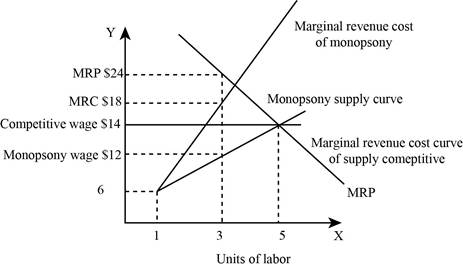
Concept explainers
Sub part (a):
The monopsony market.
Sub part (a):
Explanation of Solution
The total labor cost can be calculated by using the following formula.
Substitute the respective value in the equation (1) to calculate the total labor cost at one unit of labor.
The total labor cost is $3.
The marginal resource cost can be calculated by using the following formula.
Substitute the respective values in the equation (2) to calculate the marginal resource cost at one unit of labor.
The marginal resource cost is $3.
Table -1 shows the value of the total labor cost and the marginal resources cost that are obtained by using the equation (1) and (2).
Table -1
| Units of labor | Wage rate | Total labor cost | Marginal resources cost |
| 0 | - | 0 | |
| 1 | 6 | 6 | 6 |
| 2 | 9 | 18 | 12 |
| 3 | 12 | 36 | 18 |
| 4 | 15 | 60 | 24 |
| 5 | 18 | 90 | 30 |
| 6 | 21 | 120 | 36 |
The total revenue can be calculated by using the following formula.
The
Substitute the respective value in the equation (3) to calculate the total revenue at one unit of labor.
The total revenue is $34.
The marginal product can be calculated by using the following formula.
Substitute the respective values in the equation (4) to calculate the marginal resource cost at one unit of labor.
The marginal product is $17.
The marginal revenue product can be calculated by using the following formula.
The
Substitute the respective values in the equation (5) to calculate the marginal revenue product.
The marginal revenue product is $34.
Table -2 shows the value of the total revenue, the marginal revenue product and the marginal product that is obtained by using the equation (3), (4) and (5).
Table -2
| Units of labor | Total product | Marginal product | Product price | Total revenue | Marginal revenue product |
| 0 | 0 | 2 | 0 | ||
| 1 | 17 | 17 | 2 | 34 | 34 |
| 2 | 31 | 14 | 2 | 62 | 28 |
| 3 | 43 | 12 | 2 | 86 | 24 |
| 4 | 53 | 10 | 2 | 106 | 20 |
| 5 | 60 | 7 | 2 | 120 | 14 |
| 6 | 65 | 5 | 2 | 130 | 10 |
Graph -1 shows the firms labor supply and the marginal resources cost.7

In graph -1, the horizontal axis measures the units of labor and the vertical axis represents the wage rate. The discrete nature of problem requires that the (MRP) marginal revenue product should be equal or greater than the marginal resources cost. This marginal revenue cost curve lies above the labor supply because the employing of the next worker needs a higher wage in the market and will have to pay a higher wage for all the workers.
Concept introduction:
Monopsony: The monopsony market refers to a market which consists of a single buyer who hires a particular type of labor. The workers provide labor to this type of market that has a limited employment opportunity as they need to acquire new skills to be hired. The firm is the wage marker.
Subpart (b):
How many workers should the firm employ.
Subpart (b):
Answer to Problem 3P
The firm should employ 3 workers.
Explanation of Solution
When the marginal revenue product for this worker is greater than the marginal cost, then the firm should employ the workers. From the table, the firm should employ three workers. For the first worker, the marginal revenue product is $34 and the marginal revenue cost is $6. Thus, the firm should employ the first worker. For the second worker, the marginal revenue product is $28 and the marginal revenue cost is $12. So, the firm should employ the second worker. For the third worker, the marginal revenue product is $24 and the marginal revenue cost is $18. So the firm should employ the third worker. But for the fourth worker, the marginal revenue product is $20 and the marginal revenue cost is $24. So, the firm should not employ the forth worker.
Subpart (c):
What happens to the monopolist employment and equilibrium wage rate.
Subpart (c):
Explanation of Solution
In this, the monopolist employment decreases by 2 units and the equilibrium wage rate is $2 which is less than the competitive wage.
Want to see more full solutions like this?
Chapter 17 Solutions
Microeconomics
- how to caculate verible cost?arrow_forwardWhat is the deficit?arrow_forwardIdentify the two curves shown on the graph, and explain their upward and downward slopes. Why does curve Aintersect the horizontal axis? What is the significance of quantity d? What does erepresent? How would the optimal quantity of information change if the marginal benefit of information increased—that is, if the marginal benefit curve shifted upward?arrow_forward
- 6. Rent seeking The following graph shows the demand, marginal revenue, and marginal cost curves for a single-price monopolist that produces a drug that helps relieve arthritis pain. Place the grey point (star symbol) in the appropriate location on the graph to indicate the monopoly outcome such that the dashed lines reveal the profit-maximizing price and quantity of a single-price monopolist. Then, use the green rectangle (triangle symbols) to show the profits earned by the monopolist. 18 200 20 16 16 14 PRICE (Dollars per dose) 12 10 10 8 4 2 MC = ATC MR Demand 0 0 5 10 15 20 25 30 35 40 45 50 QUANTITY (Millions of doses per year) Monopoly Outcome Monopoly Profits Suppose that should the patent on this particular drug expire, the market would become perfectly competitive, with new firms immediately entering the market with essentially identical products. Further suppose that in this case the original firm will hire lobbyists and make donations to several key politicians to extend its…arrow_forwardConsider a call option on a stock that does not pay dividends. The stock price is $100 per share, and the risk-free interest rate is 10%. The call strike is $100 (at the money). The stock moves randomly with u=2 and d=0.5. 1. Write the system of equations to replicate the option using A shares and B bonds. 2. Solve the system of equations and determine the number of shares and the number of bonds needed to replicate the option. Show your answer with 4 decimal places (x.xxxx); do not round intermediate calculations. This is easy to do in Excel. A = B = 3. Use A shares and B bonds from the prior question to calculate the premium on the option. Again, do not round intermediate calculations and show your answer with 4 decimal places. Call premium =arrow_forwardAnswer these questions using replication or the risk neutral probability. Both methods will produce the same answer. Show your work to receive credit. 6. What is the premium of a call with a higher strike. Show your work to receive credit; do not round intermediate calculations. S0 = $100, u=2, d=0.5, r=10%, strike=$150arrow_forward
- Answer these questions using replication or the risk neutral probability. Both methods will produce the same answer.arrow_forwardProblem 2: At a raffle, 2000 tickets are sold at $5 each for five prizes of $2000, $1000, $500, $250, and $100. You buy one ticket. What is the expected value of your gain? 1. Find the gain for each prize. 2. Write a probability distribution for the possible gains. 3. Find the expected value. 4. Interpret the results.arrow_forwardThis activity focuses on developing direct and supported opinions using various sources of information on the importance of the following topics: non-renewable and renewable energies, economic factors and obstacles that can affect the relationship between international trade and economic growth, devaluation of the currency in countries, and the imbalance of economic equity. In this context, it is essential that, when studying and developing these topics, students understand the concepts of the value of currencies and that leads to devaluation, non-renewable and renewable energy resources, economic development and obstacles, distribution of wealth, economic growth and external and internal constraints, and about international trade as a growth factor. Thus, the objectives that are intended to be achieved are the following: Acquire knowledge about the concepts mentioned above. Determine relationships between economic growth and international trade. Understand what some limitations that…arrow_forward
- Consider a firm facing conventional production technology. The short run Production Function has a small range of increasing marginal product (increasing marginal returns) and then is subject to the Law of Diminishing Marginal Product (diminishing marginal returns). A. Putting quantity on the horizontal axis and dollars on the vertical axis, depict three important curves: Fixed Cost (FC), Variable Cost (VC), and Total Cost (TC). (Note that we are not asking you to depict average cost functions!) B. Please clearly indicate on this graph the range of quantities where the firm is experiencing (1) increasing marginal product and (2) diminishing marginal product. C. In a few sentences, please justify why you've made this specific classification of increasing/diminishing marginal product in part (b).arrow_forwardplease answer the following questions: What is money, and why does anyone want it? Explain the concept of the opportunity cost of holding money . Explain why an increase in U.S. interest rates relative to UK interest rates would affect the U.S.-UK exchange rate. Suppose that a person’s wealth is $50,000 and that her yearlyincome is $60,000. Also suppose that her money demand functionis given by Md = $Y10.35 - i2Derive the demand for bonds. Suppose the interest rate increases by 10 percentage points. What is the effect on her demand for bonds?b. What are the effects of an increase in income on her demand for money and her demand for bonds? Explain in wordsarrow_forwardDriving Quiz X My Course G city place w x D2L Login - Univ X D2L Login - Univ x D2L Login - U acmillanlearning.com/ihub/assessment/f188d950-dd73-11e0-9572-0800200c9a66/4db68a5e-69bb-4767-8d6c-a12d +1687 pts /1800 © Macmillan Learning Question 6 of 18 > The graph shows the average total cost (ATC) curve, the marginal cost (MC) curve, the average variable cost (AVC) curve, and the marginal revenue (MR) curve (which is also the market price) for a perfectly competitive firm that produces terrible towels. Answer the three questions, assuming that the firm is profit-maximizing and does not shut down in the short run. What is the firm's total revenue? S What is the firm's total cost? $ What is the firm's profit? (Enter a negative number for a loss.) $ Price $320 $300 $200 $150 205 260 336 365 Quantity MC ATC AVC MR=Parrow_forward
 Managerial Economics: Applications, Strategies an...EconomicsISBN:9781305506381Author:James R. McGuigan, R. Charles Moyer, Frederick H.deB. HarrisPublisher:Cengage Learning
Managerial Economics: Applications, Strategies an...EconomicsISBN:9781305506381Author:James R. McGuigan, R. Charles Moyer, Frederick H.deB. HarrisPublisher:Cengage Learning
 Principles of Economics 2eEconomicsISBN:9781947172364Author:Steven A. Greenlaw; David ShapiroPublisher:OpenStax
Principles of Economics 2eEconomicsISBN:9781947172364Author:Steven A. Greenlaw; David ShapiroPublisher:OpenStax Principles of MicroeconomicsEconomicsISBN:9781305156050Author:N. Gregory MankiwPublisher:Cengage Learning
Principles of MicroeconomicsEconomicsISBN:9781305156050Author:N. Gregory MankiwPublisher:Cengage Learning Microeconomics: Private and Public Choice (MindTa...EconomicsISBN:9781305506893Author:James D. Gwartney, Richard L. Stroup, Russell S. Sobel, David A. MacphersonPublisher:Cengage Learning
Microeconomics: Private and Public Choice (MindTa...EconomicsISBN:9781305506893Author:James D. Gwartney, Richard L. Stroup, Russell S. Sobel, David A. MacphersonPublisher:Cengage Learning





